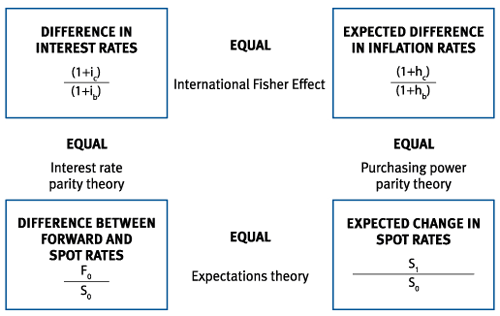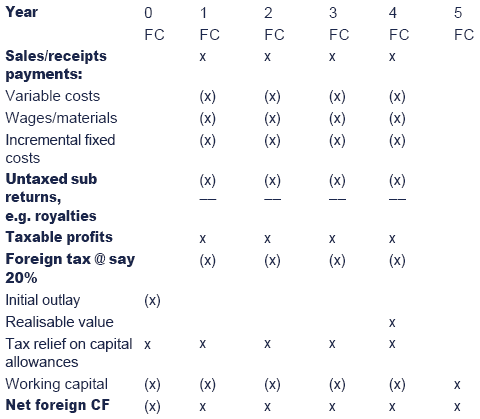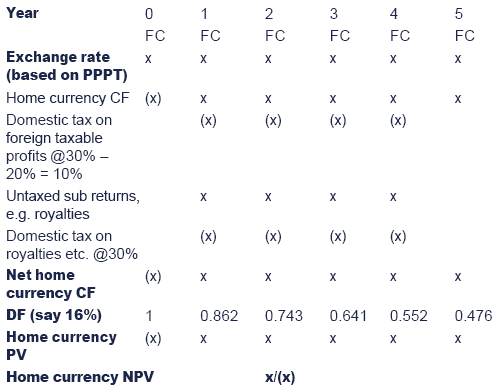International NPV calculations
When performing investment appraisal on projects involving different countries and different currencies, the main technique is NPV analysis. It includes basics such as:
However, overseas investment appraisal includes additional challenges:
- Forecasting future exchange rates
- Double taxation.
- Inter-company flows (e.g. management charges or royalties).
- Remittance restrictions.
Forecasting foreign exchange rates
To complete a NPV calculation it may be necessary to forecast exchange rates years into the future. To do this you must use the relationships between interest, inflation, spot and forward rates.
A summary of the key relationships is given in the four-way equivalence table follows.
Note :
F0 = forward rate
S0 = spot rate
S1 = expected future spot rate
ib = interest rate for base currency
ic = interest rate for counter currency
hb = inflation rate for base currency
hc = inflation rate for counter currency

To explore predicting exchange rates in further detail, please click here.
Cash flows
Taxation
The level of taxation on a project's profits will depend on the relationship between the tax rates in the home and overseas country.
There are three possible tax scenarios for an exam question.
The home country may have a tax rate that is:
- lower than
- the same as
- higher than the overseas country.
The question will always assume a double-tax treaty meaning that the project always taxed at the highest rate.
Illustration
What will be the rate of tax on a project carried out in the US by a UK company in each of the following scenarios?
Solution
- Scenario (a) - no further UK tax to pay on the project's $ profits. Profits taxed at 40% in the US.
- Scenario (b) - no further UK tax to pay on the project's $ profits. Profits taxed at 33% in the US.
- Scenario (c) - project's profits would be taxed at 33% : 25% in the US and a further 8% tax payable in the UK.
Inter-company cash flows
Inter-company cash flows, such as transfer prices, royalties and management charges, can also affect the tax computations.
Although complex in reality, in accountancy exams:
- Assume inter-company cash flows are allowable for tax (and state it) unless the question says otherwise
- If an inter-company cash flow is allowable for tax relief overseas, there will be a corresponding tax liability on the income in the home country
- Assume that the tax authorities will only allow arm's length/open-market prices for tax relief and will not allow an artificially high or low transfer price.
Transfer pricing
The transfer price is the price charged by one part of a company when supplying goods or services to another part of the company, e.g.overseas subsidiary.
Transfer prices are particularly problematical. By manipulating the transfer prices charged it may be possible to minimise the global taxation cost for the group, i.e. to report low profits in countries with high taxes and high profits in countries with low rates.
For instance, suppose we have two companies within a group that are based in different countries.
Company A sells components to Company B, whilst B sells marketing services to Company A.
- Company A will report low income therefore limiting its tax charge.
- Company B will be reporting high income as it pays less tax.
By manipulating the transfer price the overall tax charge can be lowered. However, the government of country A will not look favourably on this action.
This objective is therefore frustrated in many countries, as the relevant tax authorities require the transfer price to be set on an arm's length basis, i.e. the market price.
If an exam question tells you that a company is going to considerably increase its transfer price, you could incorporate the new price in your NPV calculations. However it is essential that you then state in your report that the policy may be unsuccessful, as most governments require the transfer price to be set on an arm's length basis, i.e. the market price.
Therefore it is preferable, for exam purposes, to assume that the tax authorities will only allow arm's length/open-market prices for tax relief and will not allow an artificially high or low transfer price.
A second problem may also arise. Although the above may decrease the taxation, the profits will end up in country B. If the currency of country B is weak relative to the holding company, then loss from the depreciation of the currency may be more than the tax saving.
Remittance restrictions
Remittance restrictions occur where an overseas government places a limit on the funds that can be repatriated back to the holding company.This restriction may change the cash flows that are received by the holding company.
The actual amount received by the parent company (and therefore the shareholders) is the relevant flow for NPV purposes.
NPV analysis for foreign projects
Overview
There are two methods for calculating the NPV of overseas projects:
The simpler 4-step method is the more conventional one which is used in the majority of cases.
Standard proforma for the conventional approach


Performing the calculation
It will be necessary to do a number of subsidiary workings in order to reach the final NPV figure, so remember the basic rules:
- Lay out your table clearly and remember you will need one column more than the length of the project if tax is lagged by a year.
- Make sure all workings are clearly referenced.
- State any assumptions and be prepared to comment on them further in any written report that follows.
The following is a guideline order of approach for the conventional approach:
(1) Calculate all the relevant flows in the foreign currency.
(2) If tax is payable on the foreign flows, deduct it.
(3) Convert the net flows into the domestic currency - you may well need to predict future exchange rates to do so.
(4) Consider whether any restrictions are placed on remittances and if so, calculate the cash flows actually received by the parent.
(5) Add any other domestic cash flows to the remitted amounts from overseas.
(6) Discount the total net cash flows in the domestic currency at an appropriate cost of capital.
|
Created at 9/14/2012 10:21 AM by System Account
(GMT) Greenwich Mean Time : Dublin, Edinburgh, Lisbon, London
|
Last modified at 11/13/2012 12:03 PM by System Account
(GMT) Greenwich Mean Time : Dublin, Edinburgh, Lisbon, London
|
|
|
|
 |
Rating
:
|
 Ratings & Comments
(Click the stars to rate the page) Ratings & Comments
(Click the stars to rate the page)
|
 |
Tags:
|
|
|
|
|